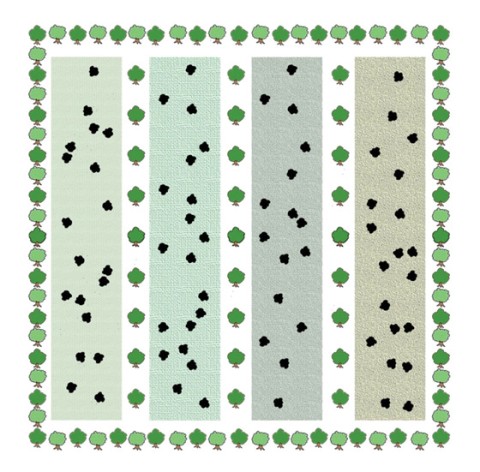Acacias in the desert: Breaking the cycle of drought

Life in Africa's Sahel region is precarious. Summer temperatures often reach 116 degrees in this ecozone that stretches from the Atlantic to Africa's Horn, between the Sahara desert and the savannas. Most soils are degraded from mismanagement. There is little biodiversity because farmers consider trees to be weeds and chop them down. Annual crops like sorghum and millet limp their way toward a meager harvest. When the rains don't come at all, famine does, and foreign aid workers appear with sacks of Nebraska wheat, while farmers watch the dunes encroach on their fields.
Now climate experts are predicting even drier conditions and increased temperatures in the Sahel, as well as increased climatic variability in the form of droughts and floods. Annual sorghum yield may decrease 15 percent by 2030. On top of all this are the pressures of population growth, adding up to a humanitarian crisis that will continue unabated for decades.
Read our latest issue or browse back issues.
But there is a way to break this cycle. Before humans started growing their monocultures here, says agricultural missionary Peter Cunningham, the ecological pattern in the Sahel was savanna. Trees were prevalent until high deforestation rates and the burning of organic matter led to severe environmental degradation, leaving soils lifeless and exposed to erosion. This resulted in poor crop yields, which led to high rates of malnutrition and extreme poverty. With 90 percent of its population farmers or herders dependent on a beleaguered landscape, it's not hard to see why Niger—one of a dozen countries that the Sahel covers parts of—is one of the poorest countries in the world.
One of the ongoing problems is farmers' dependence on monocultures that Cunningham says "should have been done away with a long time ago." Single-crop solutions don't work, including the much-heralded GMO drought-tolerant maize developed just for Africa by Monsanto. They are not robust enough to withstand the Sahel's environmental stresses.
The answer is a holistic approach based on the Sahel's original ecosystem. "In zones where God created the ecosystem as a savannah—trees, grasses, and herbs—we should follow that pattern with agriculture," says Cunningham. "If large areas of productive land once had trees and were cleared, we should go back to having trees with annual crops planted between them."
Cunningham has spent the last ten years in Niger with the interdenominational organization Serving in Mission (SIM) and has seen firsthand the amazing things that trees can do for farming. Since 1981, SIM has been working on "integrated development activities" in the Maradi region. In 1999 an outside assessment deemed two of its activities to be unqualified successes: Crop Residue Mulching (CRM), used to build fertility and restore hardpan in the soil; and Farmer Managed Natural Regeneration of trees (FMNR), a simple technique of coppicing, or cutting into indigenous tree stumps to encourage the growth of shoots for mulch and firewood. FMNR has been named as one of the most significant global success stories in the past 50 years for improving food security, benefiting over 1 million people.
Cunningham, an Australian, grew up exposed to mission work through his father, who made short-term mission trips to Papau, New Guinea. In 1991 he and his wife, Sally, backpacked their way across Africa looking for opportunities to serve. They returned to Australia, where Cunningham earned a master's degree in agronomy. Both he and Sally completed Bachelor of Ministries degrees at the Bible College of Victoria and are members of Baptist churches in Australia.
In 2000, the couple moved to Niger, and in 2005 Peter started a project called "Sowing Seeds of Change in the Sahel." Tree seeds, most notably seeds from edible acacia trees in Australia, play a key role in this agro-pastoral, alley-cropping forestry system, which uses annuals and perennials, indigenous and exotic plant species.
Acacia trees have long been known for their benefits. Cunningham points out that in Isaiah 41:18b-19a, God says, "I will make the wilderness a pool of water, and the dry land springs of water. I will put in the wilderness the cedar, the acacia, the myrtle, and the olive." Apparently Isaiah was channeling some divine agro-forestry advice; as a nitrogen-fixing tree, the acacia feeds the soil and other trees around it. Where they are planted, pools of water follow, if not visible to the eye then at least present in the soil. The Sahel could use more of both.
That's what the Farmer Managed Agroforestry Farming System (FMAFS) does. On a one-hectare farm, a farmer plants roughly 100 edible Australian acacias around the perimeter. Each tree is planted into a zai hole filled with compost. Inside the perimeter and against the prevailing wind direction, the farmer plants more acacias in rows 25 meters apart, then plants annual and perennial crops in the alleys.
The acacia fixes nitrogen in the soil; its leaves produce mulch, which is either composted or left in place rather than burned; its limbs can be coppiced for firewood, timber or mulch; and its seeds, which are high in protein (21 percent), can feed both people and livestock. Crops grown inside the rows of protective acacias have doubled and tripled in productivity; the acacias on the farm's perimeter act as a living fence, protecting against encroaching sand dunes.
The crops include sorghum, millet, cowpeas, peanuts and sesame, and trees such as Pomme du Sahel, tamarind, baobab and moringa. The farmer decides on the mix, but the common thread is biodiversity. One of the many side benefits is the comeback of native trees. Tallies on the farms show anywhere from 40 to 150 indigenous trees per hectare, including fruit trees and native acacias.
Crop yields and income generation on farms using FMAFS greatly exceed those that employ traditional farming methods. The village of Magajin Kware, for example, saw a 200 percent increase in crop income and an overall increase in farm income of 502 percent in comparison to neighboring farms. There are now 642 farms in 27 villages using this system, which is benefiting over 5,000 people.
Cunningham says that the key is trust between the farmers and SIM. "There have been countless project interventions and millions of dollars spent in Niger over the last 30 years, all aimed at reducing poverty, all with little or no lasting benefits at the village farm level."
FMAFS succeeds because it isn't the brainchild of an agronomist or a "miracle" seed like the maize dreamed up by Monsanto scientists. The answer to Niger's agricultural woes came out of the region itself and is the result of two important factors slowly colliding over a 20-year span: SIM's long-tenure rapport with farmers, and its study of the local ecosystem.
To those two factors Cunningham would add a third: divine wisdom. He cites Isaiah 58:10–11: "If you offer your food to the hungry and satisfy the needs of the afflicted, then your light shall rise in the darkness and your gloom be like the noonday. The Lord will guide you continually, and satisfy your needs in parched places, and make your bones strong; and you shall be like a watered garden, like a spring of water, whose waters never fail."
Cunningham believes that FMAFS can be replicated in other semiarid regions. Edible Australian acacias are now being planted in Tigray, Myanmar, Ethiopia, Kenya, Senegal and Mali. ECHO, the Educational Concerns for Hunger Organization, has helped spread the word. It shares this and other agricultural solutions with the poor via monthly technical papers called "ECHO Development Notes."
Instead of offering the hungry a sack of grain each year, Cunningham and others are offering something that can break the cycle of dependence and famine: locally adapted agroecological knowledge. This knowledge puts the farmer in control of her own farm and increases her chances of staying on that farm.
There is a proverb in the Hausa language: "The one who cares for trees will not go hungry." On FMAFS farms, soil fertility is increasing. Degraded lands are healing. Farmers are feeding themselves in good years and in drought years. If more Sahelian farmers employ these methods, they could begin to reverse desertification and create food-secure oases in their villages. What if those oases became so numerous that they began to overlap? What if the Sahel became, as Isaiah imagined, a land full of acacias, myrtles and springs of water?






